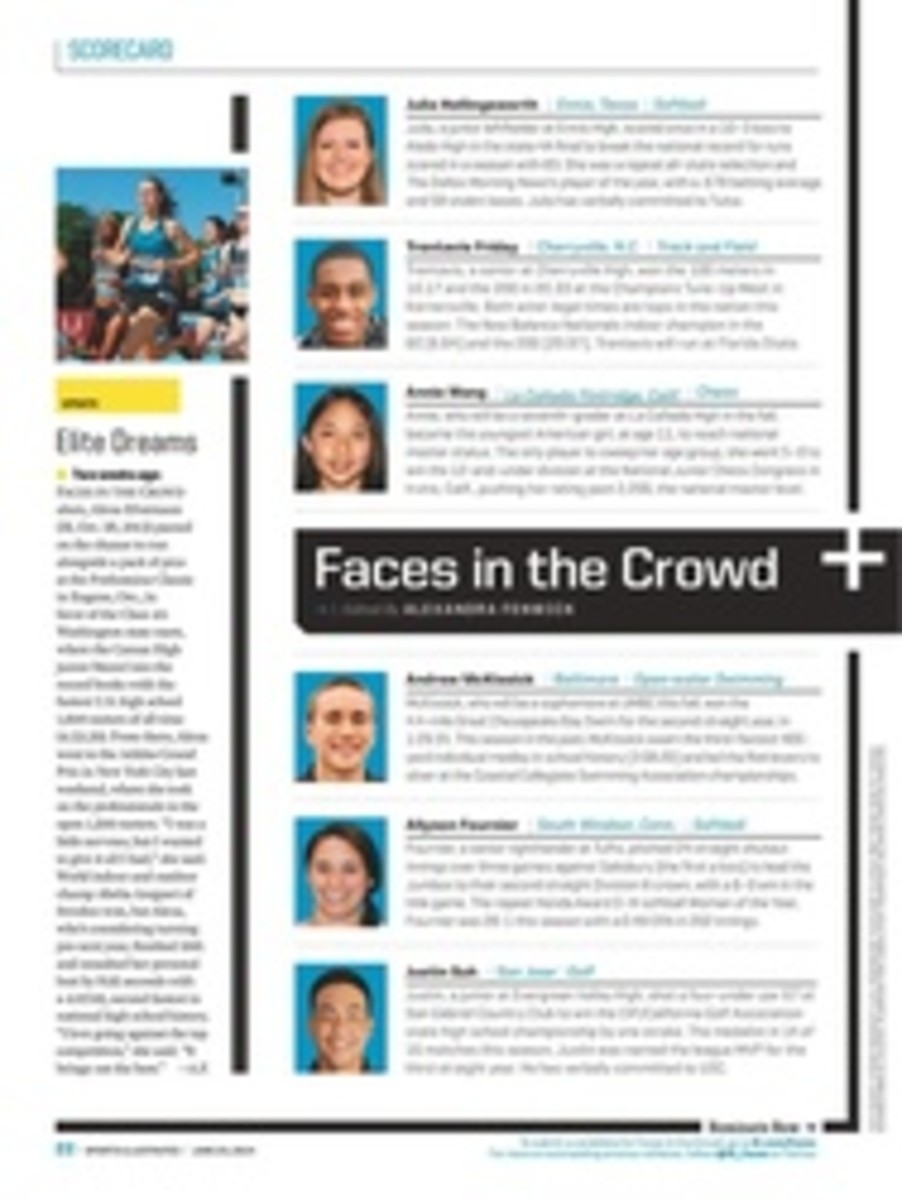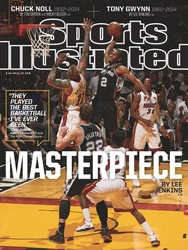
CHUCK NOLL: 1932--2014 THREE BRICKS MORE THAN A LOAD
THE ONCE EMBARRASSING futility of the Steelers' franchise has long been lost in the distant clouds of history, scarcely known to multiple generations. Pittsburgh has been so reliably good for such an extended period, with just seven losing seasons and 26 playoff appearances in the last 42 years, that the reality of what had transpired previously feels lifted from some other team's time line. A refresher: For the first 36 years of their existence, through the leather-helmeted, Rust Belt--dominated nascence of the NFL and into the early television era of the 1960s, the Steelers were 96 games below .500, with only seven winning records. They participated in just a single postseason game—losing a playoff to the Eagles in 1947—and took weekly consolation only from the bloody joy of inflicting lasting pain on more talented opponents. "Hard-hitting, lovable losers," Joe Gordon, a Pittsburgh native and the Steelers' public-relations director from 1969 to '98, told SPORTS ILLUSTRATED in 2009. "Every Monday the Chief [team founder Art Rooney] would take the back streets to work so he didn't run into any fans."
Chuck Noll changed all that. The turnaround is an endearing theme in all sports, but seldom has a franchise been so poor for long and abruptly so good for even longer. After arriving in Pittsburgh in 1969, Noll, who died at 82 last Friday after battling Alzheimer's disease and a heart condition, drafted and coached the Steelers first into relevance and then into a dynastic power. He is the only coach to win four Super Bowls, and he did it largely with homegrown talent; nine of his draftees from those teams are in the Pro Football Hall of Fame. In 23 seasons his teams won 193 games and 16 more in the playoffs. But Noll also constructed a philosophical foundation that has endured in the Steel City for more than two decades since his retirement in 1991. "He will go down as the guy who helped create the mystique that exists now with the Steelers," Bill Cowher, who followed Noll as coach in '92, told the Pittsburgh Post-Gazette.
The modern Steelers were born in January 1969, after the team had suffered through a 2-11-1 season under coach Bill Austin. Dan Rooney, the Chief's then 36-year-old son and general manager, tried to hire Joe Paterno away from Penn State to right the Steelers. Paterno said no. Rooney turned to Noll, then 37 and a defensive assistant under Don Shula with the Baltimore Colts, who had lost Super Bowl III to Joe Namath and the Jets two weeks earlier.
Noll had an impeccable football pedigree that included work with some of the most respected minds in the history of the sport. Born on Jan. 5, 1932, in Cleveland, Noll played as a guard and a linebacker for the hometown Browns from 1953 to '59 and served as one of coach Paul Brown's "messenger guards," the first players to shuttle plays from the sideline to the huddle. In a 1973 story for SI, longtime Pittsburgh writer and broadcaster Myron Cope wrote that Noll "was once described by Jim Brown as the only player who could score 100% on Paul Brown's playbook examinations."
After he retired at 28, Noll went to work as a defensive assistant for the Chargers, where he would spend six seasons under coach Sid Gilman, one of the game's most innovative offensive strategists. In 1966, Noll moved to the Colts to work under Shula, who was nearly as well regarded for his defensive expertise as Gilman was for offense. Though young when he came to Pittsburgh, Noll's football education had been exceptional. On the day after he was hired, he drafted defensive tackle Mean Joe Greene from North Texas and built his interior defense around him. A year later came quarterback Terry Bradshaw with the No. 1 pick, out of Louisiana Tech, and cornerback Mel Blount in the third round, out of Southern (the latter discovered by scout Bill Nunn, who was instrumental in helping Noll find players from historically black universities). More Hall of Fame picks followed in 1971 (linebacker Jack Ham), '72 (running back Franco Harris) and '74 (wide receivers Lynn Swann and John Stallworth, linebacker Jack Lambert and center Mike Webster).
It was an extraordinary collection of talent that Noll molded not with intimidation, but with intellect. "He was the perfect coach to play for because I didn't need to cheer three times in the locker room at halftime," Lambert told ESPN in a video celebrating Noll as No. 5 among the NFL's 20 greatest coaches. In a 1980 profile of Noll published in SI the summer after his fourth Super Bowl win, Paul Zimmerman wrote, "Rival coaches admire the ability of Noll and his staff to get the utmost from raw talent. And once that talent got to the Steelers, there were no complicated behavior codes to restrict it." Noll kept an emotional distance from his players. Zimmerman wrote of a 1979 Christmas gathering at Noll's house, which several veteran players attended. Noll played guitar and showed off some of his wildlife photography. "I saw before me not the head coach of the Pittsburgh Steelers," said Swann. "I saw a side of him not many of us had seen before."
Noll did not live inside the football cocoon. He liked good food and better wine, flew his own airplane and listened to baroque and chamber music. He encouraged players to prepare for life after football. "Find your life's pursuit," he would tell them. Most of them remembered those words as they spoke about Noll last week.
Yet like most great coaches, he was also selective in his motivational tactics. Noll worked Greene incessantly to get consistent play. "When Joe first joined the team, he was an emotional mess," linebacker Andy Russell told Zimmerman. "It was all peaks and valleys. Chuck tried to teach him that when you're on a nice, even plane, you're a much better player. And Joe turned into the most devastating player of the decade."
Likewise, Bradshaw struggled with the transition to the NFL; Joe Gilliam started the first six games of 1974, the Steelers' first championship season, before Bradshaw took over for seven of the last eight. The coach and the QB often battled on the sideline. On the day after Noll's death, Bradshaw kept a scheduled appearance at the Meadows Racetrack and Casino in Washington, Pa., part of his America's Favorite Dumb Blonde show and tour. According to the Post-Gazette, Bradshaw addressed Noll's passing at the opening of the show. "I want to show respect to one of the greatest coaches in the National Football League," said Bradshaw. "I had my moments with him. God knows I did. He took me from a spoiled kid. He slapped me around a little bit. I hated him for it. The bottom line was, we won Super Bowl championships."
It is an epitaph that Noll would appreciate, but he once asked for something simpler. In that summer of 1980, Zimmerman asked Noll how he might like to be remembered. "A teacher," Noll said. "A person who could adapt to a world of constant change. A person who could adapt to the situation. But most of all a teacher. Put down that I was a teacher."
Noll did not live inside the football cocoon. He liked good food and better wine, flew his own plane and listened to baroque and chamber music.
PHOTO
Photograph by Manny Rubio/USA Today Sports
FEELING A DRAFT Six years after taking over a train wreck of a franchise, Noll—buttressed by homegrown first-rounders Harris (32) and Greene—walked out of Tulane Stadium with the first of his four Super Bowl wins.
PHOTO
BRUCE ZAKE/AP (HALL OF FAME)
RING OF LEGENDS In 1993, four years after Bradshaw, his gunslinger and occasional nemesis, was inducted, Noll (center) entered the Hall with, from left, Dan Fouts, Larry Little, Walter Payton and Bill Walsh.
PHOTO
AP (BRADSHAW)
[See caption above]
FOUR PHOTOS
DAVID N. BERKWITZ FOR SPORTS ILLUSTRATED (RINGS)

